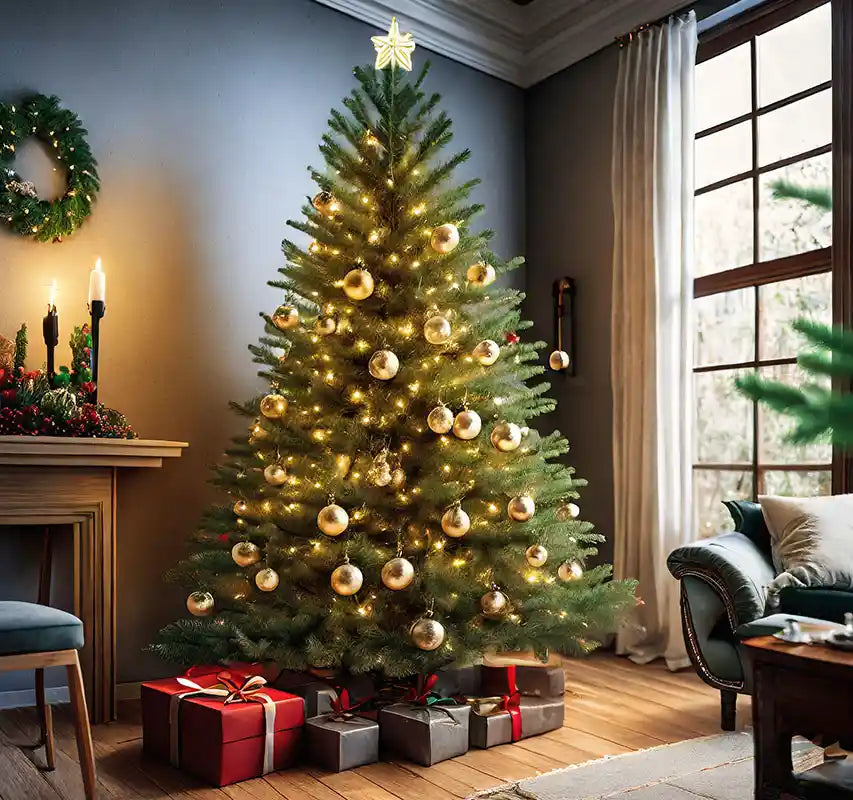Choosing the perfect Christmas tree is a cherished holiday tradition. This guide will help you navigate the festive forest to find a tree that brings joy and warmth to your home.
5 Keys for Picking The Best Christmas Tree
Size and Shape
Measure your space to ensure a perfect fit. Remember, it's not just about height – width matters too! Leave room for the tree topper and stand.
Needle Retention
Opt for species like the Fraser Fir for longevity. Their excellent needle retention keeps your tree vibrant throughout the season.
Color and Appearance
Look for a rich green color. Embrace natural imperfections – they add character!
Trunk Straightness
A straight trunk is ideal, but modern stands can handle some imperfections.
Freshness Test
Gently bend a branch. If it snaps back, it's a sign of good health.
Types of Christmas Trees: Finding Your Perfect Match
Selecting the right type of Christmas tree is crucial for creating the desired holiday atmosphere in your home. Each variety has its unique characteristics, from needle retention and scent to shape and size. Here's a deeper look into some popular types:
Fir Trees: The Fragrant Choice
- Fraser Fir: Celebrated for its pleasant scent and good needle retention. Its branches are sturdy, making it ideal for hanging heavier ornaments.

- Balsam Fir: Known for its distinct fragrance and conical shape. It's a traditional choice that brings a classic Christmas feel to your home.

- Noble Fir: Prized for its beautiful symmetry and long-lasting needles. Its strong branches are perfect for a variety of decorations.

Pine Trees: The Lush and Long-Lasting
- Scotch Pine: One of the most popular Christmas trees, recognized for its bright green color and excellent needle retention. It's resilient and doesn't drop needles even when dry.

- White Pine: With soft, flexible needles and a graceful appearance, it's ideal for those who prefer a more delicate look. However, it's less suitable for heavy ornaments.

Spruce Trees: The Traditional Touch
- Blue Spruce: Known for its lovely blue hue and pyramid shape. It has sharp needles, which can be a deterrent for pets and small children.

- Norway Spruce: A classic choice in many parts of the world, it has a beautiful shape and a rich green color. However, it tends to lose needles quickly, so it's best when purchased closer to Christmas.

Exotic and Eco-Friendly Options
- Leyland Cypress: A great choice for those with allergies, as it doesn't produce sap or have a strong scent. It has a dense, feathery appearance.

- Eastern Red Cedar: A traditional choice in the southern U.S., it has a lovely fragrance and a dense, pyramidal shape. It's best for shorter display periods due to quicker needle drop.

Making an Eco-Conscious Choice
- Living Christmas Trees: Potted trees that can be replanted after the holidays, a sustainable option that benefits the environment.
- Recycled Trees: Post-holiday, many trees can be recycled into mulch or used in erosion control, making them an eco-friendly choice.
- Artificial Christmas Tree
Pros and Cons of Different Christmas Trees
Fir Trees
- Fraser Fir
- Pros: Excellent needle retention, pleasant scent, sturdy branches for heavy ornaments.
- Cons: Can be more expensive than other varieties.
- Balsam Fir
- Pros: Classic Christmas tree scent, traditional conical shape.
- Cons: Needles may drop in warmer indoor environments.
- Noble Fir
- Pros: Beautiful symmetry, long-lasting needles, strong branches.
- Cons: Higher price point due to its premium qualities.
Pine Trees
- Scotch Pine
- Pros: Bright green color, excellent needle retention, resilient to drying.
- Cons: Stiff branches may be challenging to decorate for some.
- White Pine
- Pros: Soft, flexible needles, full and lush appearance.
- Cons: Not suitable for heavy ornaments, less fragrant.
Spruce Trees
- Blue Spruce
- Pros: Attractive blue hue, classic Christmas tree shape.
- Cons: Sharp needles can be uncomfortable during decorating.
- Norway Spruce
- Pros: Traditional appearance, rich green color.
- Cons: Fast needle drop, best for short-term display.
Exotic and Eco-Friendly Options
- Leyland Cypress
- Pros: Good for allergy sufferers, dense foliage.
- Cons: Lacks the traditional pine scent, less traditional look.
- Eastern Red Cedar
- Pros: Pleasant fragrance, dense shape.
- Cons: Quick needle drop, best in cooler climates.
Living Christmas Trees (Potted)
- Pros: Sustainable, can be replanted, reduces carbon footprint.
- Cons: Requires more care, limited indoor display time to ensure survival.
Recycled Trees
- Pros: Eco-friendly post-holiday disposal, can be repurposed.
- Cons: Limited to varieties that are accepted for recycling programs.
Recommended Varieties for Different Home Setups
Compact Spaces
Douglas Fir or Balsam Fir fit well in tighter spaces.
Allergy-Sensitive Environments
Leyland Cypress or Eastern Red Cedar are less likely to trigger allergies.
Long-Lasting Display
Fraser Fir and Noble Fir are ideal for extended festive periods.
Setting Up Your Tree
Ensure a safe and beautiful setup with a sturdy stand and careful positioning away from heat sources.

Maintaining Your Tree
Regular watering and avoiding sprays that alter the natural scent are crucial. Products like "Tree Life" or pennies in the water can help extend its life.
Expert Insights
Vianne Siu, the creative director at Flower Actually, shares how to choose the perfect tree.
"As the festive season approaches, selecting the right Christmas tree becomes a highlight for many families. Here are my top tips for making this choice a memorable part of your holiday preparations:
- Sense of Scale: It's not just the height; the tree's girth is equally important. A tree that's too wide can overwhelm a space, while one that's too narrow may look underwhelming. Consider the dimensions of your room before making a choice.
- Quality of Needles: Look for trees with vibrant, green needles that are firmly attached to the branches. A simple test is to tug on a branch gently. If needles fall off easily, it's a sign the tree may not last through the season.
- Aroma Matters: One of the joys of a real Christmas tree is its natural fragrance. Trees like the Fraser Fir or Balsam Fir are not only visually stunning but also fill your home with a delightful, festive scent.
- Eco-Friendly Options: If sustainability is a concern, look for locally grown trees or those certified by an environmental organization. This ensures you're enjoying the holiday spirit while being kind to the planet.”
Decorator's Tips for a Stunning Christmas Tree Display
"Decorating your Christmas tree is an art form that brings the spirit of the season to life. Here are some of my favorite tips for creating a tree that's both beautiful and uniquely yours:
- Lighting Layout: Begin with the lights, working from the inside out. This technique adds depth and warmth to your tree. LED lights in warm white can create a cozy, inviting glow.
- Thematic Consistency: Choose a theme that resonates with your personal style or home decor. Whether it's a color scheme, a rustic look, or a winter wonderland theme, consistency is key to a harmonious design.
- Layering Decorations: Start with the larger ornaments, spacing them evenly, and then fill in with smaller ones. This creates a balanced, full look. Don't forget to add special ornaments that hold sentimental value – they add a personal touch that makes your tree unique.
- Topper Selection: The tree topper is a crowning glory. Whether it's a traditional star, an angel, or something more modern, choose a topper that complements your overall theme.
- Natural Elements: Incorporating natural elements like pinecones, berries, or wooden ornaments can add an organic touch to your tree, making it feel more connected to nature."
Conclusion
Your Christmas tree is a centerpiece of holiday memories. With this guide, you're ready to choose the best Christmas tree that brings joy, beauty, and the spirit of the season into your home. Happy tree hunting!

